E-Postcard #6
from Our British Isles Holiday
11/4 to 11/22/2002
Hi Everyone,
As we left Wales, we began the “big city” phase of our trip. With few mountains, seashore, and Neolithic ruins, there might be a tendency for this to be an “If we are in Chester, it must be Tuesday” kind of time. All the cities we saw had three or more of the following: cathedral, castle, medieval buildings housing shops, town walls, Roman ruins, Saxon towers, and statues of long-dead kings. However, we were pleasantly surprised at the differences we saw. Here is the rundown:
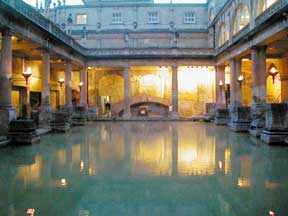
Bath. As the name implies, this city had been famous, even in Roman times, for its hot mineral spring. The Romans built the first formal baths here by an ingenious system of enclosing the marsh around the spring and using underground pipes to bring the reportedly healing mineral water into a series of large tile and marble baths for its soldiers. The Victorians rebuilt the ruins of these baths in a pseudo-Roman style and the city has been a popular resort ever since. Although the baths were closed a few years ago due to a (false) meningitis scare, we saw construction of a huge spa resort complex encompassing some of the old buildings. There is an extensive tour of the excavated Roman site. You’ve got to admire those guys, some of their lead plumbing is still in working order and the baths’ tile work and sculptures are wonderful. On our free city tour, our guide took us into back alleys and showed us how houses were built above the street level so coal delivered though chutes in the street would end up in the cellar.
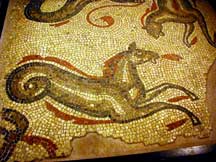 She also pointed out how the sanitation worked in a civilized town before there were flush toilets. (For some reason, Di finds this stuff fascinating.) A tour of the city’s costume museum included clothing from outrageous hooped skirts six feet wide to Jennifer Lopez’s green almost-frontless Oscar dress. I can only say thank goodness for jeans! Fireworks were seen on the night of November 5 to celebrate Guy Fawkes Day. He was a Catholic revolutionary who tried (and failed) to blow up the Protestant Parliament and King in the 1600s. Like Independence Day in the U.S., people buy personal (possibly illegal) fireworks and blow them off for days before the actual celebration. Also, every little town celebrates so we were able to see lots of different displays from the hill on which we were staying. By the way, we can’t think of another holiday that celebrates the failure of something to happen (like Guy Fawkes attempt), can you?
She also pointed out how the sanitation worked in a civilized town before there were flush toilets. (For some reason, Di finds this stuff fascinating.) A tour of the city’s costume museum included clothing from outrageous hooped skirts six feet wide to Jennifer Lopez’s green almost-frontless Oscar dress. I can only say thank goodness for jeans! Fireworks were seen on the night of November 5 to celebrate Guy Fawkes Day. He was a Catholic revolutionary who tried (and failed) to blow up the Protestant Parliament and King in the 1600s. Like Independence Day in the U.S., people buy personal (possibly illegal) fireworks and blow them off for days before the actual celebration. Also, every little town celebrates so we were able to see lots of different displays from the hill on which we were staying. By the way, we can’t think of another holiday that celebrates the failure of something to happen (like Guy Fawkes attempt), can you?
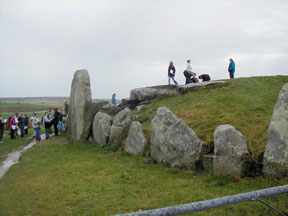
Neolithic ruin sidetrip. Although we have Stonehenge on our agenda later, we stopped at the stone circle in Avebury (much larger and 500 years older than Stonehenge). The circle of large stones (some 12 feet tall) was so huge it essentially enclosed half the town. As the place was almost deserted, we could take pictures galore. Nearby is a long (100 feet) five-chambered barrow tomb (an above ground tunnel). I can’t imagine the work it took to build this mound from rock. It was a quick walk to reach the tomb through very muddy farmer’s fields. We hurriedly scanned the chambers. We were trying to beat out the school bus full of kids that had just arrived. We can move pretty fast for two middle aged tourists if we need to!
Oxford. How different this university town is from an Ann Arbor or East Lansing. Oxford University is actually a collection of 30 small residential colleges, each with its own buildings, libraries and private grounds.
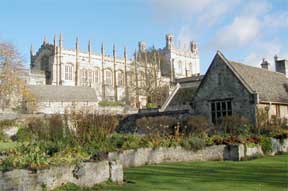 Since many of the colleges charged for admission and we are basically cheapskates, we did a self-guided tour around town and photographed the outside of the colleges with their very old entry ways. Tim stopped to climb Saxon-built tower and see a bird’s eye view of the town while I had a nice conversation with an old woman selling poppies for Remembrance (Veteran’s) Day. Everywhere you look you see a mixture of the old university buildings with new shops. The bookstores were fantastic, but I restrained myself and left town with only a long list of the math books I want to buy (and one very touristy Oxford pullover). We also walked through the botanical garden (oldest in Britain) and greenhouses. Although very little was blooming outdoors (except some roses), the gardens had not yet been winterized so we could get a feel of how lovely they must look in summer. Everything is labeled but, unfortunately, the staff was around so I couldn’t stick any seeds in my pocket (yeah, like they would grow in our shady garden!). I loved this town and could spend months here, while Tim thought it was snooty.
Since many of the colleges charged for admission and we are basically cheapskates, we did a self-guided tour around town and photographed the outside of the colleges with their very old entry ways. Tim stopped to climb Saxon-built tower and see a bird’s eye view of the town while I had a nice conversation with an old woman selling poppies for Remembrance (Veteran’s) Day. Everywhere you look you see a mixture of the old university buildings with new shops. The bookstores were fantastic, but I restrained myself and left town with only a long list of the math books I want to buy (and one very touristy Oxford pullover). We also walked through the botanical garden (oldest in Britain) and greenhouses. Although very little was blooming outdoors (except some roses), the gardens had not yet been winterized so we could get a feel of how lovely they must look in summer. Everything is labeled but, unfortunately, the staff was around so I couldn’t stick any seeds in my pocket (yeah, like they would grow in our shady garden!). I loved this town and could spend months here, while Tim thought it was snooty.
Bard stop: We did the two hour tour of Stratford-upon-Avon, home of Shakespeare. Actually, he was born here and died here but spent most of his time elsewhere. That doesn’t stop the locals from capitalizing on his fame. From Portia’s clothing shop to Hamlet’s sandwiches, the town is for tourists. Even the cemetery where Will is buried was crowded with live tourists.
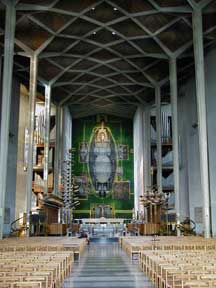 A walk along the non-town side of the Avon River restores your sanity and lets you see the old buildings of the town from a safe distance. This place must be a zoo during the summer months, it was crowded enough during a rainy weekend in November.
A walk along the non-town side of the Avon River restores your sanity and lets you see the old buildings of the town from a safe distance. This place must be a zoo during the summer months, it was crowded enough during a rainy weekend in November.
Coventry. After Stratford we made a quick stop at the Coventry Cathedral. Although the original building was bombed by the Germans in WWII, the city kept the ruins as a memorial and built a new, modern church next door. This is a glorious structure with large abstract stained glass windows, several circular chapels, and a multistory tapestry on the main wall. The central crucifix is made of bomb-twisted metal from the old cathedral window frames. The theme is forgiveness for past wrongs and international peace. The mood is one of quiet hope. Even if you are not religious, you leave this place with a sense of awe.
Warwick. This town still has old city gates, narrow streets with cobblestones, and a feel of a medieval village. Although we had seen a few castles so far, we thought we would tour Warwick Castle (see attached photo).
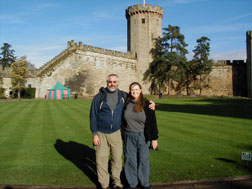 Wow! Despite the intermittent rain, this place was worth every pence of admission. It had a haunted tower, a dungeon with some pretty gruesome torture devices, a walk around the top of the castle walls and up the battlement towers (including 530 steps), a working portcullis (that metal grate they let down over a castle doorway), conservatory and gardens with peacocks, and wax figurine displays of life during Victorian and medieval times. The castle had been lived in from the 1100s until 1970 (when its owners moved to Australia because of high inheritance taxes) and had been taken over by Tussauds (of wax museum fame). We ended up spending the day here. We attended evensong (an early evening service) in St. Mary’s Church with a choir singing and organ playing. Although Warwick doesn’t have an official cathedral, this church deserved to be with its vaulted ceiling and Norman crypt. The attendance was sparse so the music reverberated throughout the building. Since it was Remembrance Day here (a time to reflect on the war dead) and as prayers for a peaceful settlement of the Iraqi problem were said, it was a stirring service.
Wow! Despite the intermittent rain, this place was worth every pence of admission. It had a haunted tower, a dungeon with some pretty gruesome torture devices, a walk around the top of the castle walls and up the battlement towers (including 530 steps), a working portcullis (that metal grate they let down over a castle doorway), conservatory and gardens with peacocks, and wax figurine displays of life during Victorian and medieval times. The castle had been lived in from the 1100s until 1970 (when its owners moved to Australia because of high inheritance taxes) and had been taken over by Tussauds (of wax museum fame). We ended up spending the day here. We attended evensong (an early evening service) in St. Mary’s Church with a choir singing and organ playing. Although Warwick doesn’t have an official cathedral, this church deserved to be with its vaulted ceiling and Norman crypt. The attendance was sparse so the music reverberated throughout the building. Since it was Remembrance Day here (a time to reflect on the war dead) and as prayers for a peaceful settlement of the Iraqi problem were said, it was a stirring service.
Cadbury World. If you were brought up in Britain, you would probably salivate at the mention of Cadbury. For a century and a half, it has been the manufacturer of popular chocolate bars, especially the famous Dairy Milk (UK equivalent of a Hershey bar).
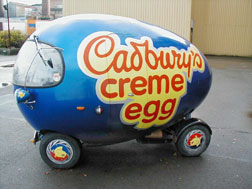 Nearby Warwick is Cadbury World, a huge multilevel display dedicated to chocolate, its history, and the making of Cadbury candies. The factory is in the town of Bournemouth, which was actually designed by the Cadbury brothers for the ”social and spiritual benefit” of their workers and families. This meant that the workers ate (segregated by sexes) in multistory lunchrooms, participated in group activities after work and the women were fired if they got married. Cadbury World itself is a strange place, a variety of animated displays. It is supposedly for all ages but we thought maybe kids would enjoy it most. Actually, if you remember that the UK is the origin of Monty Python, Benny Hill, Mr. Bean, and Blackpool, it gives you a good idea of the type of entertainment provided. I think we are a little old to travel in small cars through a village of little dancing chocolate drops, but at least they weren’t singing “It’s a small world after all”. The factory tour was interesting and Tim is still enjoying the “free” samples (Di is not a fan of milk chocolate). Oh well, it is a taste of Britain.
Nearby Warwick is Cadbury World, a huge multilevel display dedicated to chocolate, its history, and the making of Cadbury candies. The factory is in the town of Bournemouth, which was actually designed by the Cadbury brothers for the ”social and spiritual benefit” of their workers and families. This meant that the workers ate (segregated by sexes) in multistory lunchrooms, participated in group activities after work and the women were fired if they got married. Cadbury World itself is a strange place, a variety of animated displays. It is supposedly for all ages but we thought maybe kids would enjoy it most. Actually, if you remember that the UK is the origin of Monty Python, Benny Hill, Mr. Bean, and Blackpool, it gives you a good idea of the type of entertainment provided. I think we are a little old to travel in small cars through a village of little dancing chocolate drops, but at least they weren’t singing “It’s a small world after all”. The factory tour was interesting and Tim is still enjoying the “free” samples (Di is not a fan of milk chocolate). Oh well, it is a taste of Britain.
Chester. What a great surprise Chester was. As we looked at our itinerary the day before, we couldn’t really remember why we decided to come here in the first place.
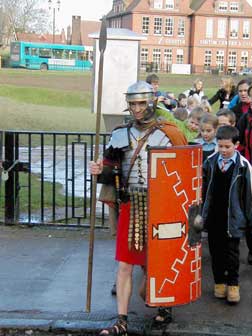 Our first stop was the cathedral where a bunch of children sprawled all over the main aisle while they sketched features of the church. We have seen this in several museums as well. I think it’s great as it gets the kids involved and looking for details, making a church or museum more than just old buildings filled with dusty objects. Chester has wonderful city walls you can walk on, the remains of a Roman amphitheater, and a world class zoo. As we walked about, we saw a Roman centurion leading a group of school children on a tour. As he made them march down the street to some Latin phrase, I was thinking that there is nothing like a Roman soldier to maintain a little order, even today. We have been to a lot of zoos and a rainy November day is not always conducive to having the animals outside, but the zoo in Chester had lots to keep us entertained. There was a huge bat house. Inside, the bats were not within cages and, as your eyes adjusted to the darkened room, you could see dozens of them flying, hanging upside down, chattering, stretching, and eating. Occasionally you could feel the air move as one swooped very near. There was even a group of five teenage boy bats that the guide said roamed around and caused trouble (hmmm, a universal trait). Most of the animals had large open areas to roam, resulting in a zoo so big we had to rush to see it all. A special, new display on the jaguar (sponsored, naturally, by the Jaguar car company) had two beautiful animals sauntering about.
Our first stop was the cathedral where a bunch of children sprawled all over the main aisle while they sketched features of the church. We have seen this in several museums as well. I think it’s great as it gets the kids involved and looking for details, making a church or museum more than just old buildings filled with dusty objects. Chester has wonderful city walls you can walk on, the remains of a Roman amphitheater, and a world class zoo. As we walked about, we saw a Roman centurion leading a group of school children on a tour. As he made them march down the street to some Latin phrase, I was thinking that there is nothing like a Roman soldier to maintain a little order, even today. We have been to a lot of zoos and a rainy November day is not always conducive to having the animals outside, but the zoo in Chester had lots to keep us entertained. There was a huge bat house. Inside, the bats were not within cages and, as your eyes adjusted to the darkened room, you could see dozens of them flying, hanging upside down, chattering, stretching, and eating. Occasionally you could feel the air move as one swooped very near. There was even a group of five teenage boy bats that the guide said roamed around and caused trouble (hmmm, a universal trait). Most of the animals had large open areas to roam, resulting in a zoo so big we had to rush to see it all. A special, new display on the jaguar (sponsored, naturally, by the Jaguar car company) had two beautiful animals sauntering about.
Lincoln. This is a large city but we didn’t travel far outside the old town. Here we stayed in one of the most interesting of places, an old bishop’s residence that was converted to a meeting house and B&B.
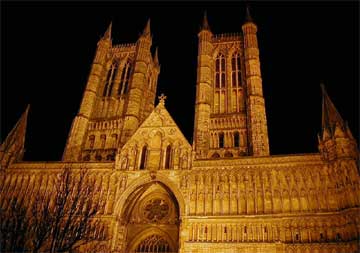 The atmosphere was subdued but welcoming, very clean and (I am sure) it is probably the only B&B with its own private chapel. A “light” breakfast of cereal, juice, fruit, yogurt, toast, and croissants was served amidst surrounding tables of ministers and fellow travelers. Every window (including the bathroom) looked out on a priory garden, a chapel, or the city below. Next door was the ruins of the medieval bishop’s palace (no vow of poverty for him!) and through a private door in the residence garden wall was Lincoln cathedral. These buildings and the castle are atop a hill and most of the town below is reached via Steep Street (which was very aptly named). We wanted to see the cathedral but were unable to fit it in until the morning before we left town. We arrived at 8:30 a.m. (it opens at 7:30) and we were the only people there. Wow, nothing makes you feel insignificant like a little you in the vastness of an empty cathedral (at one time the largest building in Europe). We have been reading “Sarum” in which cathedral building is described. It was interesting to search out some of the idiosyncrasies of the structure, like the stone imp peeking out from behind a saint’s beard or the gargoyle/rain spout sticking out his tongue.
The atmosphere was subdued but welcoming, very clean and (I am sure) it is probably the only B&B with its own private chapel. A “light” breakfast of cereal, juice, fruit, yogurt, toast, and croissants was served amidst surrounding tables of ministers and fellow travelers. Every window (including the bathroom) looked out on a priory garden, a chapel, or the city below. Next door was the ruins of the medieval bishop’s palace (no vow of poverty for him!) and through a private door in the residence garden wall was Lincoln cathedral. These buildings and the castle are atop a hill and most of the town below is reached via Steep Street (which was very aptly named). We wanted to see the cathedral but were unable to fit it in until the morning before we left town. We arrived at 8:30 a.m. (it opens at 7:30) and we were the only people there. Wow, nothing makes you feel insignificant like a little you in the vastness of an empty cathedral (at one time the largest building in Europe). We have been reading “Sarum” in which cathedral building is described. It was interesting to search out some of the idiosyncrasies of the structure, like the stone imp peeking out from behind a saint’s beard or the gargoyle/rain spout sticking out his tongue.
Sherwood Forest. Nearby Lincoln is Sherwood Forest of Robin Hood fame. Historically, there may not have been a real Robin Hood; his legend was most likely a combination of good natured outlaws living here in the middle ages and the Greene Man, a mythical English forest creature.
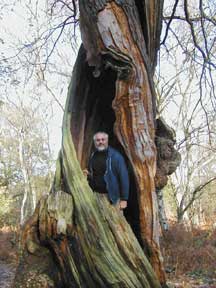 If he did exist, he probably did not look like Errol Flynn or Kevin Costner. However, there was a real Little John (who was a giant), a Will Scarlet, and an unscrupulous Sheriff of Nottingham. Unfortunately, Sherwood Forest is not very large (much was lumbered centuries ago) but I and my merry man walked the forest path anyway. It passed by lots of oak trees over 500 years old. One, the Major Oak, is claimed to be 700 years old and has a 30 foot “waistline”. Many of its branches are held up by metal posts, but it is a stately tree, nonetheless. The twisted form of these trees reminded me of the trees that come alive in “Wizard of Oz” and “Sleepy Hollow” movies. You can picture the outlaw band living here.
If he did exist, he probably did not look like Errol Flynn or Kevin Costner. However, there was a real Little John (who was a giant), a Will Scarlet, and an unscrupulous Sheriff of Nottingham. Unfortunately, Sherwood Forest is not very large (much was lumbered centuries ago) but I and my merry man walked the forest path anyway. It passed by lots of oak trees over 500 years old. One, the Major Oak, is claimed to be 700 years old and has a 30 foot “waistline”. Many of its branches are held up by metal posts, but it is a stately tree, nonetheless. The twisted form of these trees reminded me of the trees that come alive in “Wizard of Oz” and “Sleepy Hollow” movies. You can picture the outlaw band living here.
Fog and Fen alert. En route to Norwich, we traveled the East Anglian coastal highway. Well, we think it was along the coast. Several days of fog has obscured the tall and the far away. Londoners may call their fog pea soup; I think this is more like watery cream of mushroom. Fortunately, there wasn’t a lot of traffic along this road. Unfortunately, we think there were sea cliffs out there somewhere. The entire area was originally marsh (or fen, as they call it here). Houses and the few small villages were built on the high ground and people would use boats to get around. Think of the Everglades without the trees and alligators. Eager landowners brought in some Dutch men to drain the fens using windmills to pump out the water, leaving incredibly fertile farmland. Some of these windmills still exist, (we did see one) but days of rain here made many fields look like they were turning back to fens.
Norwich. A few decades ago, this city boasted a church for every Sunday in the year and a pub for every day in the year. Now they are down to only 30 churches and 300 pubs. We unwisely drove into town armed with only a very detailed map to find the tourist information center. Hoards of Christmas shoppers, winding unsigned streets and traffic accidents didn’t help as we searched for a place to park. As we started to see the same stores three times, we pulled into a large parking structure within a shopping mall and hit the pavement.
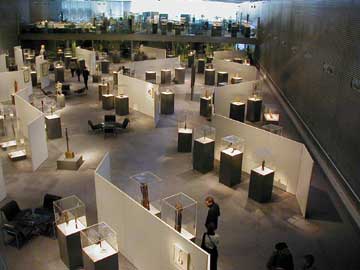 Although we didn’t intend to, we walked the scenic route and needed a policeman’s directions to find the place. Then, we were unable to remember exactly where we parked. Luckily the guardian angel of tourists was watching over us as we found the car. She then promptly abandoned us. Finding our way out of town to the B&B involved several more circles and U-turns around town and three trips down the same stretch of road (Di was reading the map backwards). It was with great pleasure that our hostess told us that you can walk into town in less than ten minutes. Undaunted, we later went for a late stroll along the river walk and got lost again (as the parts of the path way were closed). All ended well as we listened to the church bells ring in the evening in view of the public buildings lit for the holidays. Near the city is the Sainsbury Center for Visual Art, a gallery on a university campus that houses the art collection of a famous entrepreneur. It was the art he and his wife collected; not because it was all great art, but because they liked it. There were Picassos drawings and Egyptian figurines, Henry Moore sculptures and Alaskan whalebone harpoon handles, a diverse but always interesting group of things. A special exhibit of large textiles by an 80 year old local artist was located in an underground gallery. We spent more time here than we expected, and we didn’t get lost either there or back.
Although we didn’t intend to, we walked the scenic route and needed a policeman’s directions to find the place. Then, we were unable to remember exactly where we parked. Luckily the guardian angel of tourists was watching over us as we found the car. She then promptly abandoned us. Finding our way out of town to the B&B involved several more circles and U-turns around town and three trips down the same stretch of road (Di was reading the map backwards). It was with great pleasure that our hostess told us that you can walk into town in less than ten minutes. Undaunted, we later went for a late stroll along the river walk and got lost again (as the parts of the path way were closed). All ended well as we listened to the church bells ring in the evening in view of the public buildings lit for the holidays. Near the city is the Sainsbury Center for Visual Art, a gallery on a university campus that houses the art collection of a famous entrepreneur. It was the art he and his wife collected; not because it was all great art, but because they liked it. There were Picassos drawings and Egyptian figurines, Henry Moore sculptures and Alaskan whalebone harpoon handles, a diverse but always interesting group of things. A special exhibit of large textiles by an 80 year old local artist was located in an underground gallery. We spent more time here than we expected, and we didn’t get lost either there or back.
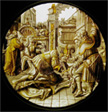
Ely. En route to Cambridge was the stained glass museum of Ely. It was built on the balcony of the cathedral, overlooking the main aisle. There were examples from the 1500s to present day. Although the day was foggy (again!), this collection of stained glass was lit from behind. It was neat to be able to look very closely at the way the glass was assembled and whether the design was within the glass it self or painted on.
Cambridge. This city had a different feel than its sister university town of Oxford. The college arrangement was the same, but the town itself is much larger.
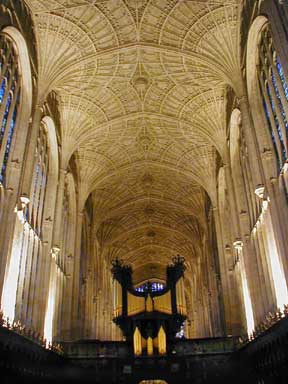 Bicycles are everywhere and the roads are marked to accommodate them. We bit the bullet and took a guided tour of the city which included admission to several colleges, including the famous chapel of King’s College. This chapel rivals several cathedrals we have seen. Originally built for 70 students, it has intricate carvings on the ceiling and walls, biblical scenes on the stained glass windows and a few personal touches. One is the intertwined initials of Henry VIII and his second wife Anne Boleyn, although she was executed before the carving was finished. Nearby is a carving of a screaming woman (who is supposedly the estranged wife of one of the workmen). There is also the carving of the Virgin Mary with her face missing (chipped off during the Reformation). A lot of history can be learned by just looking around. Again we hit the bookstores and again we left town with just the Cambridge shirts. This time I had my eye on the Complete Cambridge History of Food but the 8 inch thick books wouldn’t fit under my coat or in my pack (not to mention maxing out the Visa card). Tim felt that Cambridge was more vibrant than Oxford with theatre and seminars open to the public going on every day. I thought the town was uninspiring.
Bicycles are everywhere and the roads are marked to accommodate them. We bit the bullet and took a guided tour of the city which included admission to several colleges, including the famous chapel of King’s College. This chapel rivals several cathedrals we have seen. Originally built for 70 students, it has intricate carvings on the ceiling and walls, biblical scenes on the stained glass windows and a few personal touches. One is the intertwined initials of Henry VIII and his second wife Anne Boleyn, although she was executed before the carving was finished. Nearby is a carving of a screaming woman (who is supposedly the estranged wife of one of the workmen). There is also the carving of the Virgin Mary with her face missing (chipped off during the Reformation). A lot of history can be learned by just looking around. Again we hit the bookstores and again we left town with just the Cambridge shirts. This time I had my eye on the Complete Cambridge History of Food but the 8 inch thick books wouldn’t fit under my coat or in my pack (not to mention maxing out the Visa card). Tim felt that Cambridge was more vibrant than Oxford with theatre and seminars open to the public going on every day. I thought the town was uninspiring.
Windsor. This is the site of Windsor Castle, home of the Royal family. It contains an extensive art collection and historical exhibits. On my list was Queen Mary’s dollhouse, an exact replica of a manor in 1:12 scale complete with working plumbing and tiny books in the library handwritten by famous authors.
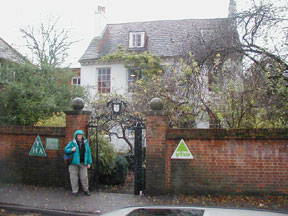 Unfortunately, the dollhouse was being cleaned so we decided to skip the tour. (How does one clean a dollhouse? With little mops and dusters? And what if the plumbing plugs up? Do you call for a little plumber?) In the morning, we gazed out at the rare sunny sky and decided to walk the town. For the next two hours it rained constantly. We walked anyway. Windsor is a fairly exclusive town with expensive clothing and antique shops. Across the Thames River (via bridge) is Eton, home of the private boys’ school. We felt slightly out of place as we walked by. The streets were full of boys on their way to class. Each was dressed in pinstriped trousers, crisp white shirts, and long tailed formal jackets. The masters (teachers) wear something like a black graduation gown. This is the required uniform. I wonder if the boys are any better behaved in class because of it.
Unfortunately, the dollhouse was being cleaned so we decided to skip the tour. (How does one clean a dollhouse? With little mops and dusters? And what if the plumbing plugs up? Do you call for a little plumber?) In the morning, we gazed out at the rare sunny sky and decided to walk the town. For the next two hours it rained constantly. We walked anyway. Windsor is a fairly exclusive town with expensive clothing and antique shops. Across the Thames River (via bridge) is Eton, home of the private boys’ school. We felt slightly out of place as we walked by. The streets were full of boys on their way to class. Each was dressed in pinstriped trousers, crisp white shirts, and long tailed formal jackets. The masters (teachers) wear something like a black graduation gown. This is the required uniform. I wonder if the boys are any better behaved in class because of it.
We are off tomorrow to pick up our friends Rick and Chris Hamill at Heathrow Airport. With them we will be cruising Scotland (more distilleries and the Isle of Skye) then heading down to Cornwall. We hope that your Thanksgiving dinners are successful and the holiday restful. Take care,
Di and Tim
 She also pointed out how the sanitation worked in a civilized town before there were flush toilets. (For some reason, Di finds this stuff fascinating.) A tour of the city’s costume museum included clothing from outrageous hooped skirts six feet wide to Jennifer Lopez’s green almost-frontless Oscar dress. I can only say thank goodness for jeans! Fireworks were seen on the night of November 5 to celebrate Guy Fawkes Day. He was a Catholic revolutionary who tried (and failed) to blow up the Protestant Parliament and King in the 1600s. Like Independence Day in the U.S., people buy personal (possibly illegal) fireworks and blow them off for days before the actual celebration. Also, every little town celebrates so we were able to see lots of different displays from the hill on which we were staying. By the way, we can’t think of another holiday that celebrates the failure of something to happen (like Guy Fawkes attempt), can you?
She also pointed out how the sanitation worked in a civilized town before there were flush toilets. (For some reason, Di finds this stuff fascinating.) A tour of the city’s costume museum included clothing from outrageous hooped skirts six feet wide to Jennifer Lopez’s green almost-frontless Oscar dress. I can only say thank goodness for jeans! Fireworks were seen on the night of November 5 to celebrate Guy Fawkes Day. He was a Catholic revolutionary who tried (and failed) to blow up the Protestant Parliament and King in the 1600s. Like Independence Day in the U.S., people buy personal (possibly illegal) fireworks and blow them off for days before the actual celebration. Also, every little town celebrates so we were able to see lots of different displays from the hill on which we were staying. By the way, we can’t think of another holiday that celebrates the failure of something to happen (like Guy Fawkes attempt), can you?


 Since many of the colleges charged for admission and we are basically cheapskates, we did a self-guided tour around town and photographed the outside of the colleges with their very old entry ways. Tim stopped to climb Saxon-built tower and see a bird’s eye view of the town while I had a nice conversation with an old woman selling poppies for Remembrance (Veteran’s) Day. Everywhere you look you see a mixture of the old university buildings with new shops. The bookstores were fantastic, but I restrained myself and left town with only a long list of the math books I want to buy (and one very touristy Oxford pullover). We also walked through the botanical garden (oldest in Britain) and greenhouses. Although very little was blooming outdoors (except some roses), the gardens had not yet been winterized so we could get a feel of how lovely they must look in summer. Everything is labeled but, unfortunately, the staff was around so I couldn’t stick any seeds in my pocket (yeah, like they would grow in our shady garden!). I loved this town and could spend months here, while Tim thought it was snooty.
Since many of the colleges charged for admission and we are basically cheapskates, we did a self-guided tour around town and photographed the outside of the colleges with their very old entry ways. Tim stopped to climb Saxon-built tower and see a bird’s eye view of the town while I had a nice conversation with an old woman selling poppies for Remembrance (Veteran’s) Day. Everywhere you look you see a mixture of the old university buildings with new shops. The bookstores were fantastic, but I restrained myself and left town with only a long list of the math books I want to buy (and one very touristy Oxford pullover). We also walked through the botanical garden (oldest in Britain) and greenhouses. Although very little was blooming outdoors (except some roses), the gardens had not yet been winterized so we could get a feel of how lovely they must look in summer. Everything is labeled but, unfortunately, the staff was around so I couldn’t stick any seeds in my pocket (yeah, like they would grow in our shady garden!). I loved this town and could spend months here, while Tim thought it was snooty.
 A walk along the non-town side of the Avon River restores your sanity and lets you see the old buildings of the town from a safe distance. This place must be a zoo during the summer months, it was crowded enough during a rainy weekend in November.
A walk along the non-town side of the Avon River restores your sanity and lets you see the old buildings of the town from a safe distance. This place must be a zoo during the summer months, it was crowded enough during a rainy weekend in November.
 Wow! Despite the intermittent rain, this place was worth every pence of admission. It had a haunted tower, a dungeon with some pretty gruesome torture devices, a walk around the top of the castle walls and up the battlement towers (including 530 steps), a working portcullis (that metal grate they let down over a castle doorway), conservatory and gardens with peacocks, and wax figurine displays of life during Victorian and medieval times. The castle had been lived in from the 1100s until 1970 (when its owners moved to Australia because of high inheritance taxes) and had been taken over by Tussauds (of wax museum fame). We ended up spending the day here. We attended evensong (an early evening service) in St. Mary’s Church with a choir singing and organ playing. Although Warwick doesn’t have an official cathedral, this church deserved to be with its vaulted ceiling and Norman crypt. The attendance was sparse so the music reverberated throughout the building. Since it was Remembrance Day here (a time to reflect on the war dead) and as prayers for a peaceful settlement of the Iraqi problem were said, it was a stirring service.
Wow! Despite the intermittent rain, this place was worth every pence of admission. It had a haunted tower, a dungeon with some pretty gruesome torture devices, a walk around the top of the castle walls and up the battlement towers (including 530 steps), a working portcullis (that metal grate they let down over a castle doorway), conservatory and gardens with peacocks, and wax figurine displays of life during Victorian and medieval times. The castle had been lived in from the 1100s until 1970 (when its owners moved to Australia because of high inheritance taxes) and had been taken over by Tussauds (of wax museum fame). We ended up spending the day here. We attended evensong (an early evening service) in St. Mary’s Church with a choir singing and organ playing. Although Warwick doesn’t have an official cathedral, this church deserved to be with its vaulted ceiling and Norman crypt. The attendance was sparse so the music reverberated throughout the building. Since it was Remembrance Day here (a time to reflect on the war dead) and as prayers for a peaceful settlement of the Iraqi problem were said, it was a stirring service.
 Nearby Warwick is Cadbury World, a huge multilevel display dedicated to chocolate, its history, and the making of Cadbury candies. The factory is in the town of Bournemouth, which was actually designed by the Cadbury brothers for the ”social and spiritual benefit” of their workers and families. This meant that the workers ate (segregated by sexes) in multistory lunchrooms, participated in group activities after work and the women were fired if they got married. Cadbury World itself is a strange place, a variety of animated displays. It is supposedly for all ages but we thought maybe kids would enjoy it most. Actually, if you remember that the UK is the origin of Monty Python, Benny Hill, Mr. Bean, and Blackpool, it gives you a good idea of the type of entertainment provided. I think we are a little old to travel in small cars through a village of little dancing chocolate drops, but at least they weren’t singing “It’s a small world after all”. The factory tour was interesting and Tim is still enjoying the “free” samples (Di is not a fan of milk chocolate). Oh well, it is a taste of Britain.
Nearby Warwick is Cadbury World, a huge multilevel display dedicated to chocolate, its history, and the making of Cadbury candies. The factory is in the town of Bournemouth, which was actually designed by the Cadbury brothers for the ”social and spiritual benefit” of their workers and families. This meant that the workers ate (segregated by sexes) in multistory lunchrooms, participated in group activities after work and the women were fired if they got married. Cadbury World itself is a strange place, a variety of animated displays. It is supposedly for all ages but we thought maybe kids would enjoy it most. Actually, if you remember that the UK is the origin of Monty Python, Benny Hill, Mr. Bean, and Blackpool, it gives you a good idea of the type of entertainment provided. I think we are a little old to travel in small cars through a village of little dancing chocolate drops, but at least they weren’t singing “It’s a small world after all”. The factory tour was interesting and Tim is still enjoying the “free” samples (Di is not a fan of milk chocolate). Oh well, it is a taste of Britain.
 Our first stop was the cathedral where a bunch of children sprawled all over the main aisle while they sketched features of the church. We have seen this in several museums as well. I think it’s great as it gets the kids involved and looking for details, making a church or museum more than just old buildings filled with dusty objects. Chester has wonderful city walls you can walk on, the remains of a Roman amphitheater, and a world class zoo. As we walked about, we saw a Roman centurion leading a group of school children on a tour. As he made them march down the street to some Latin phrase, I was thinking that there is nothing like a Roman soldier to maintain a little order, even today. We have been to a lot of zoos and a rainy November day is not always conducive to having the animals outside, but the zoo in Chester had lots to keep us entertained. There was a huge bat house. Inside, the bats were not within cages and, as your eyes adjusted to the darkened room, you could see dozens of them flying, hanging upside down, chattering, stretching, and eating. Occasionally you could feel the air move as one swooped very near. There was even a group of five teenage boy bats that the guide said roamed around and caused trouble (hmmm, a universal trait). Most of the animals had large open areas to roam, resulting in a zoo so big we had to rush to see it all. A special, new display on the jaguar (sponsored, naturally, by the Jaguar car company) had two beautiful animals sauntering about.
Our first stop was the cathedral where a bunch of children sprawled all over the main aisle while they sketched features of the church. We have seen this in several museums as well. I think it’s great as it gets the kids involved and looking for details, making a church or museum more than just old buildings filled with dusty objects. Chester has wonderful city walls you can walk on, the remains of a Roman amphitheater, and a world class zoo. As we walked about, we saw a Roman centurion leading a group of school children on a tour. As he made them march down the street to some Latin phrase, I was thinking that there is nothing like a Roman soldier to maintain a little order, even today. We have been to a lot of zoos and a rainy November day is not always conducive to having the animals outside, but the zoo in Chester had lots to keep us entertained. There was a huge bat house. Inside, the bats were not within cages and, as your eyes adjusted to the darkened room, you could see dozens of them flying, hanging upside down, chattering, stretching, and eating. Occasionally you could feel the air move as one swooped very near. There was even a group of five teenage boy bats that the guide said roamed around and caused trouble (hmmm, a universal trait). Most of the animals had large open areas to roam, resulting in a zoo so big we had to rush to see it all. A special, new display on the jaguar (sponsored, naturally, by the Jaguar car company) had two beautiful animals sauntering about.
 The atmosphere was subdued but welcoming, very clean and (I am sure) it is probably the only B&B with its own private chapel. A “light” breakfast of cereal, juice, fruit, yogurt, toast, and croissants was served amidst surrounding tables of ministers and fellow travelers. Every window (including the bathroom) looked out on a priory garden, a chapel, or the city below. Next door was the ruins of the medieval bishop’s palace (no vow of poverty for him!) and through a private door in the residence garden wall was Lincoln cathedral. These buildings and the castle are atop a hill and most of the town below is reached via Steep Street (which was very aptly named). We wanted to see the cathedral but were unable to fit it in until the morning before we left town. We arrived at 8:30 a.m. (it opens at 7:30) and we were the only people there. Wow, nothing makes you feel insignificant like a little you in the vastness of an empty cathedral (at one time the largest building in Europe). We have been reading “Sarum” in which cathedral building is described. It was interesting to search out some of the idiosyncrasies of the structure, like the stone imp peeking out from behind a saint’s beard or the gargoyle/rain spout sticking out his tongue.
The atmosphere was subdued but welcoming, very clean and (I am sure) it is probably the only B&B with its own private chapel. A “light” breakfast of cereal, juice, fruit, yogurt, toast, and croissants was served amidst surrounding tables of ministers and fellow travelers. Every window (including the bathroom) looked out on a priory garden, a chapel, or the city below. Next door was the ruins of the medieval bishop’s palace (no vow of poverty for him!) and through a private door in the residence garden wall was Lincoln cathedral. These buildings and the castle are atop a hill and most of the town below is reached via Steep Street (which was very aptly named). We wanted to see the cathedral but were unable to fit it in until the morning before we left town. We arrived at 8:30 a.m. (it opens at 7:30) and we were the only people there. Wow, nothing makes you feel insignificant like a little you in the vastness of an empty cathedral (at one time the largest building in Europe). We have been reading “Sarum” in which cathedral building is described. It was interesting to search out some of the idiosyncrasies of the structure, like the stone imp peeking out from behind a saint’s beard or the gargoyle/rain spout sticking out his tongue.
 If he did exist, he probably did not look like Errol Flynn or Kevin Costner. However, there was a real Little John (who was a giant), a Will Scarlet, and an unscrupulous Sheriff of Nottingham. Unfortunately, Sherwood Forest is not very large (much was lumbered centuries ago) but I and my merry man walked the forest path anyway. It passed by lots of oak trees over 500 years old. One, the Major Oak, is claimed to be 700 years old and has a 30 foot “waistline”. Many of its branches are held up by metal posts, but it is a stately tree, nonetheless. The twisted form of these trees reminded me of the trees that come alive in “Wizard of Oz” and “Sleepy Hollow” movies. You can picture the outlaw band living here.
If he did exist, he probably did not look like Errol Flynn or Kevin Costner. However, there was a real Little John (who was a giant), a Will Scarlet, and an unscrupulous Sheriff of Nottingham. Unfortunately, Sherwood Forest is not very large (much was lumbered centuries ago) but I and my merry man walked the forest path anyway. It passed by lots of oak trees over 500 years old. One, the Major Oak, is claimed to be 700 years old and has a 30 foot “waistline”. Many of its branches are held up by metal posts, but it is a stately tree, nonetheless. The twisted form of these trees reminded me of the trees that come alive in “Wizard of Oz” and “Sleepy Hollow” movies. You can picture the outlaw band living here.
 Although we didn’t intend to, we walked the scenic route and needed a policeman’s directions to find the place. Then, we were unable to remember exactly where we parked. Luckily the guardian angel of tourists was watching over us as we found the car. She then promptly abandoned us. Finding our way out of town to the B&B involved several more circles and U-turns around town and three trips down the same stretch of road (Di was reading the map backwards). It was with great pleasure that our hostess told us that you can walk into town in less than ten minutes. Undaunted, we later went for a late stroll along the river walk and got lost again (as the parts of the path way were closed). All ended well as we listened to the church bells ring in the evening in view of the public buildings lit for the holidays. Near the city is the Sainsbury Center for Visual Art, a gallery on a university campus that houses the art collection of a famous entrepreneur. It was the art he and his wife collected; not because it was all great art, but because they liked it. There were Picassos drawings and Egyptian figurines, Henry Moore sculptures and Alaskan whalebone harpoon handles, a diverse but always interesting group of things. A special exhibit of large textiles by an 80 year old local artist was located in an underground gallery. We spent more time here than we expected, and we didn’t get lost either there or back.
Although we didn’t intend to, we walked the scenic route and needed a policeman’s directions to find the place. Then, we were unable to remember exactly where we parked. Luckily the guardian angel of tourists was watching over us as we found the car. She then promptly abandoned us. Finding our way out of town to the B&B involved several more circles and U-turns around town and three trips down the same stretch of road (Di was reading the map backwards). It was with great pleasure that our hostess told us that you can walk into town in less than ten minutes. Undaunted, we later went for a late stroll along the river walk and got lost again (as the parts of the path way were closed). All ended well as we listened to the church bells ring in the evening in view of the public buildings lit for the holidays. Near the city is the Sainsbury Center for Visual Art, a gallery on a university campus that houses the art collection of a famous entrepreneur. It was the art he and his wife collected; not because it was all great art, but because they liked it. There were Picassos drawings and Egyptian figurines, Henry Moore sculptures and Alaskan whalebone harpoon handles, a diverse but always interesting group of things. A special exhibit of large textiles by an 80 year old local artist was located in an underground gallery. We spent more time here than we expected, and we didn’t get lost either there or back.

 Bicycles are everywhere and the roads are marked to accommodate them. We bit the bullet and took a guided tour of the city which included admission to several colleges, including the famous chapel of King’s College. This chapel rivals several cathedrals we have seen. Originally built for 70 students, it has intricate carvings on the ceiling and walls, biblical scenes on the stained glass windows and a few personal touches. One is the intertwined initials of Henry VIII and his second wife Anne Boleyn, although she was executed before the carving was finished. Nearby is a carving of a screaming woman (who is supposedly the estranged wife of one of the workmen). There is also the carving of the Virgin Mary with her face missing (chipped off during the Reformation). A lot of history can be learned by just looking around. Again we hit the bookstores and again we left town with just the Cambridge shirts. This time I had my eye on the Complete Cambridge History of Food but the 8 inch thick books wouldn’t fit under my coat or in my pack (not to mention maxing out the Visa card). Tim felt that Cambridge was more vibrant than Oxford with theatre and seminars open to the public going on every day. I thought the town was uninspiring.
Bicycles are everywhere and the roads are marked to accommodate them. We bit the bullet and took a guided tour of the city which included admission to several colleges, including the famous chapel of King’s College. This chapel rivals several cathedrals we have seen. Originally built for 70 students, it has intricate carvings on the ceiling and walls, biblical scenes on the stained glass windows and a few personal touches. One is the intertwined initials of Henry VIII and his second wife Anne Boleyn, although she was executed before the carving was finished. Nearby is a carving of a screaming woman (who is supposedly the estranged wife of one of the workmen). There is also the carving of the Virgin Mary with her face missing (chipped off during the Reformation). A lot of history can be learned by just looking around. Again we hit the bookstores and again we left town with just the Cambridge shirts. This time I had my eye on the Complete Cambridge History of Food but the 8 inch thick books wouldn’t fit under my coat or in my pack (not to mention maxing out the Visa card). Tim felt that Cambridge was more vibrant than Oxford with theatre and seminars open to the public going on every day. I thought the town was uninspiring.
 Unfortunately, the dollhouse was being cleaned so we decided to skip the tour. (How does one clean a dollhouse? With little mops and dusters? And what if the plumbing plugs up? Do you call for a little plumber?) In the morning, we gazed out at the rare sunny sky and decided to walk the town. For the next two hours it rained constantly. We walked anyway. Windsor is a fairly exclusive town with expensive clothing and antique shops. Across the Thames River (via bridge) is Eton, home of the private boys’ school. We felt slightly out of place as we walked by. The streets were full of boys on their way to class. Each was dressed in pinstriped trousers, crisp white shirts, and long tailed formal jackets. The masters (teachers) wear something like a black graduation gown. This is the required uniform. I wonder if the boys are any better behaved in class because of it.
Unfortunately, the dollhouse was being cleaned so we decided to skip the tour. (How does one clean a dollhouse? With little mops and dusters? And what if the plumbing plugs up? Do you call for a little plumber?) In the morning, we gazed out at the rare sunny sky and decided to walk the town. For the next two hours it rained constantly. We walked anyway. Windsor is a fairly exclusive town with expensive clothing and antique shops. Across the Thames River (via bridge) is Eton, home of the private boys’ school. We felt slightly out of place as we walked by. The streets were full of boys on their way to class. Each was dressed in pinstriped trousers, crisp white shirts, and long tailed formal jackets. The masters (teachers) wear something like a black graduation gown. This is the required uniform. I wonder if the boys are any better behaved in class because of it.